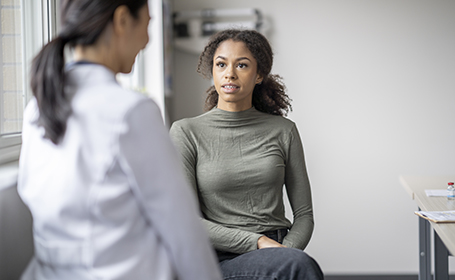
Endometriosis Q&A
Endometriosis is a condition where cells of the uterine lining are found outside the womb. It can cause a variety of issues including chronic pain, fatigue and infertility. We asked three of our leading women's health consultants about the condition, which is thought to affect 1 in 10 women worldwide
Mrs Kavita Goswami, Mr Christopher Mann and Mr Alvan Priddy are three consultant gynaecologists specialising in the treatment of endometriosis. Here they give us their answers to some of the most frequently asked questions about this common but often overlooked condition.
What are the most common symptoms of endometriosis?
Mrs Kavita Goswami: Endometriosis symptoms can vary, as can the severity of the symptoms. Some women won't have any symptoms at all, others will have a variety, many of which can be very difficult to live with.
Typically, a patient suffering from endometriosis will experience some or all of the following:
- Pelvic pain, which can sometimes be confused with colorectal and bladder problems
- Pain during intercourse
- Painful periods
- Heavy, irregular periods
- Infertility
It is estimated that 1 in 10 women will have endometriosis at some point during their fertile years.
Who is affected by endometriosis?
Mr Christopher Mann: Endometriosis can affect women who are in the fertile period, so from the start of their periods until menopause. It is very rare to experience endometriosis after menopause.
It is estimated that 1 in 10 women will have endometriosis at some point during their fertile years. Not all will experience symptoms, but for many people the condition causes chronic and life-changing symptoms.
What causes endometriosis?
Mr Alvan Priddy: The exact cause is not known, however there are several factors that are believed to be at play. These include:
- Retrograde menstruation (where some cells from the womb lining spill backwards along the fallopian tubes at the time of menstruation)
- Genetic factors (as it is more common in families)
- Lymphatic or circulatory spread (to distant sites such as the lung, kidney)
- Auto-immune factors (where the immune system is not able to fight off endometriosis)
- Metaplasia (where in the womb one type of cell changes to a different kind of cell and then some adult cells retain the ability to transform into endometriotic cells)

How is the condition diagnosed?
Mrs Kavita Goswami: Usually, a clinical diagnosis would be made by either a GP or a gynaecologist and you would then be referred to a specialist for further treatment. An ultrasound scan of the pelvis can also be used to support the diagnosis, though it's possible for an ultrasound to miss the presence of endometriosis.
To confirm the diagnosis, the gold standard of treatment is a laparoscopy.
This is usually a day case procedure where the patient has a general anaesthetic and a tiny camera is passed through a small insertion in the abdomen so that the consultant can view the endometrial tissue, allowing for small samples to be taken if required.
What non-surgical treatments are currently available?
Mr Christopher Mann: There are non-surgical options available that may help ease or manage the symptoms of endometriosis.
In terms of medical therapies, the most commonly used are the combined oral contraceptive pill, the progesterone only pill (the mini pill), low dose progesterone, or the coil. It should be noted that none of these therapies actually get rid of the disease. They simply reduce the severity of the symptoms in a proportion of, but not all, patients.
It's also possible to use extremely powerful drugs that release hormone agonists, which induce a medical menopause. However, these are drugs with severe side-effect profiles and as such are only used for a very short time period. In fact, they are only licensed for a six month period.
Again, these drugs do not get rid of the disease, they simply make the symptoms less severe in a proportion of patients.
Within six months of stopping any of the drugs mentioned above, the vast majority of patients will have found that their symptoms have returned.
Most endometriosis surgeries will be laparascopic (keyhole), though sometimes if the condition is more advanced there may be a need for open surgery.
What is involved in surgery for endometriosis?
Mr Alvan Priddy: There are two types of surgery to treat endometriosis:
- Ablation (thermal destruction of endometriosis)
- Excision (cutting out the endometriosis)
While ablation may remove superficial endometriosis, it may fail to treat the deeper roots of the disease. For this reason excision, which removes the endometriosis at a deeper level, is believed to be more effective.
Surgery for endometriosis can be technically very difficult and should only be performed by experienced specialists.
Most endometriosis surgeries will be laparascopic (keyhole), though sometimes if the condition is more advanced there may be a need for open surgery. In some cases, where the endometriosis has spread to other organs, your gynaecologist may perform the surgery jointly with a bowel or bladder specialist.
If you have ovarian cysts or endometriosis-related adhesions, your surgeon may also remove these during the procedure.
Endometriosis deposits can be excised or ablated (with diathermy or laser), ovarian cysts can be removed, and adhesions (scar tissue) can be released to improve both pain and fertility.
Some patients with very severe endometriosis will need a laparotomy (a larger incision on the abdomen) and surgery performed jointly by the gynaecologist and a bowel surgeon or bladder surgeon (urologist).
In some patients who have severe recurrent endometriosis and their family is complete, a hysterectomy will be recommended.
What can patients expect from recover after a laparoscopy?
Mr Alvan Priddy: Surgery will be performed under general anaesthetic. After a general anaesthetic, a patient can feel groggy and nauseous.
A tube is inserted into the throat to help breathing during the laparoscopy so afterwards the throat may feel sore. Gas (carbon dioxide) is used to distend the abdomen at laparoscopy and although removed at the end of the operation, excess gas can cause some discomfort.
There may be some vaginal bleeding. Most people feel some discomfort following the laparoscopy. All these symptoms are treated with medication.
For the first couple of days patients need to rest and allow their body to recover from the procedure. Gently moving around will help excess gas to leave the body.
It is normal to feel weak and tired and it can take up to 14 days to recover from significant laparoscopic surgery. Due to the stitches, patients should be careful bending, stretching and washing. Normally the stitches will dissolve and will be hidden under the skin (subcutaneous).
It's not unusual to feel emotional ups and downs following surgery. This will pass over time and it's important for patients to give themselves time to recover physically and emotionally.
An experienced nurse and doctor will be sensitive to all these issues and help ensure their patient makes a good recovery.
Endometriosis can be managed but not cured... Unfortunately, the most invasive option is more likely to give a lasting effect.
Can endometriosis be cured?
Mrs Kavita Goswami: Endometriosis can be managed but not cured.
Non-surgical and minimally invasive surgery will help with the management of the symptoms. But even following surgery where the endometrial tissue is removed there is a possibility of recurrence over time.
Unfortunately, the most invasive option is more likely to give a lasting effect, which is the hysterectomy with the removal of the fallopian tubes and ovaries.
What should patients look for in a consultant?
Mr Christopher Mann: Ideally patients should look for a consultant who has a particular interest in endometriosis and also has experience of a laparoscopic approach for excising the disease.
It's important that patients also approach consultants who ideally work in a team environment with input from general/bowel surgeons, urology surgeons, as well as pain management specialists and an experienced radiological consultant.
Tags
How do I book an appointment?
If you're concerned about symptoms you're experiencing or require further information on this subject, talk to a GP or see an expert consultant at your local Circle Hospital.